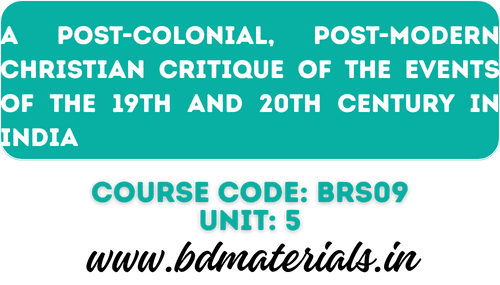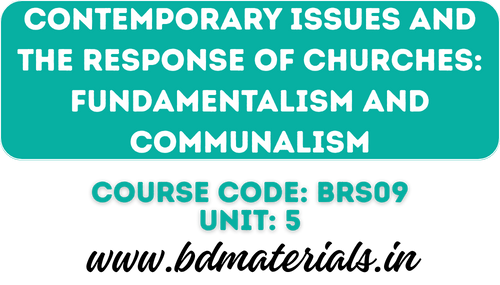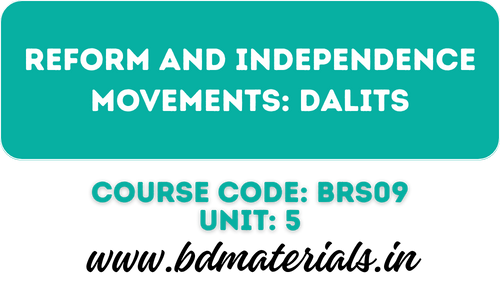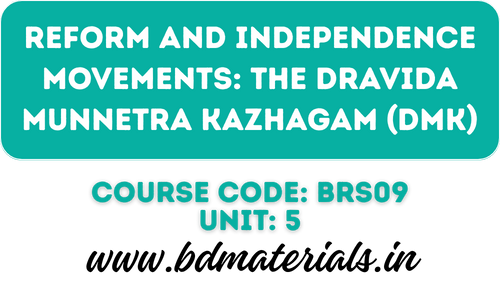NEO – BUDDHISM: Ambedkar and the Neo-Buddhist Movement
Social Reform Movements and Untouchables in Maharashtra: The second half of the 19th century marked the beginning of the socio-religious reform movements started by Indian leaders. The so- called untouchables “Dalits” were not influenced in Maharastra though there were followers of Brahmo-Samaj and Ary-Samaj. These Dalits neither supported nor opposed the Indian National Congress at that time. Maharastra had saints from all castes including “out-castes”, for example, Namdev and Chokamela were untouchables who are still worshipped and respected. Many saints tried to eradicate untouchability, but not succeeded.
Jotirao Phooley, an untouchable, started a major social reform movement called Satya Shodhak Samaj (Truth Seeking Society), in the year 1873. The untouchable communities of Maharastra Mahars and Mangs supported this movement. Phooley was the first Indian Social Reformer who was honoured by the title, “Mahatma” for the awareness he brought among untouchables about the social, religious and political consciousness. The aims of the Satya Shodhak Samaj: a) to teach that all human beings are children of one God who is their parent, b) there is no need for intermediary such as a priest, or a preceptor to enable the devotee to his/her God. Phooley brought all the untouchables in Maharastra under the banner.
B. R. AMBEDKAR:
He was born on April 14th 1893 in the Mahar Caste, which was one of the largest outcastes in Maharstra and the fourteenth son to his parents. He suffered much due to his outcaste identity in schools where the upper caste teachers and students did not touch him. He was treated in the society as an untouchable in all aspects of daily life. He was not allowed to drink water, travel, and play games with upper castes. However he was educated due to the magnanimity of Raja of Baroda – Sayaji Rao. He passed Matriculation from Elphinstone High School in 1907. A copy of Kelusakar’s book, Life of Gauthama Buddha was presented to him and it became a great challenge to his life in adopting Gauthama Buddha’s life. He also read Narasu’s book Essence of Buddhism. These books greatly influenced his life and became Buddhist (at heart) at the age of sixteen.
He completed his degree from Columbia University, with the generous help of Sayaji Rao, studied economics in England and also qualifies himself as a barrister. Sayaji Rao gave him job in his government, but the upper castes continued to treat him inhumanly, so he left the job and went to Baroda.
He went to Bombay and worked as a barrister where his fellow advocates sitting and eating with him. He came to conclusion on the study of Hinduism that its social philosophy is based on inequality, hence, started quest for new religion that provide equality of all human beings. The beginning of Ambedkar’s entry into Indian politics is after the publication of the book Mook Nayak (leader of the dumb) in 1920.
His conversion: Yola Conference in 1935
On October 13th 1935, the leaders of the untouchables convened a conference in Yola, Nasik, to review the political and social situation in the light of their ten-year struggle. They passed a resolution that “the depressed classes should leave the Hindu-fold and join some other religion that gives social and religious equality to them. Choose any religion that gives you equality of status and of treatment”. Ambedkar expressed his conviction not to die as a Hindu. But it was not mentioned in the resolution that which religion should replace Hinduism. Leaders of various religions, following Ambedkar’s decision, invited Ambedkar to consider their religions. Bishop J.W.Picket and Doctor E. Stanley Jones requested him to consider the claims of Christianity. Buddhists, Sikhs and Muslims had also approached him.
Poona Conference in 1936:
This conference was convened in Poona on January 12th 1936 to think and consider Yola decision, where important decisions were made. A) The chairperson of the meeting said, “The only way to get rid of Untouchability is that the depressed classes should leave the Hindu religion, not necessarily by conversion to another religion already existing but by possibly by starting a new religion or by reviving the ancient one practiced among the Adi-Dravidas, long before the Aryans brought to India Hinduism with its various customs”. B) The question of choosing a religion was entirely left to Ambedkar. C) The immediate concern was not conversion but consolidation. Ambedkar warned his people that wherever they go, they will have to fight for their welfare.
Nagapur Conference in 1956:
Ambedkar took twenty years to decide which religion he should accept. The year 1956 marked the 2500th anniversary of the Mahaparinirvana- the death of Buddha. Ambedkar thought that Buddhism was the only solution to the problem of untouchability. He took “diksa” (initiation) on October 14th 1956, Dasara day and became a Buddhist in a public ceremony. On that day 3, 00,000 people joined Buddhism along with Ambedkar. On the same day he founded Bharatiya Buddha Mahasabha (Buddhist Society of India), to propagate Buddhist dharma among the untouchables. Next day Ambedkar concluded his speech that, “this conversion has given me enormous satisfaction and pleasure unimaginable. I feel as If I have been liberated from hell”. On December 6th 1956, only seven weeks after his conversion, he died fulfilling his determination that was not to die as Hindu. Ambedkar’s wife Savitabai and Yeshvant Rao also accepted Buddhism. Within two years after the conversion of Ambedkar, the Neo-Buddhist population was about eighteen to twenty millions.
Recognition:
In 1947, Ambedkar became the law Minister of the Government of India. He took a leading part in the framing of the Indian Constitution. He was able to frame the Constitution that there is no discrimination against the untouchables. In 1952 the Constitution declared that there is no discrimination against the untouchables. In 1952 the Columbia University bestowed upon him a doctorate; in 1953 Osmania University also honoured him with doctorate. In 1990 the Indian Government has given him the distinctive title, Bharata Ratna.
AMBEDKAR’S EVALUATION OF RELIGIONS:
Christianity: 1) They loss Indian (Hindu) cultural identify, if Dalits join in Christianity. 2) They would be denationalized. 3) It leads to strengthen the hold of British rule. 4) Since Christianity worked through the Hindu structure of caste system and was split into denominations, Ambedkar was doubtful whether Christianity could unify the untouchables who themselves were already much sub-divided. 5) Ambedkar saw the Christian Missions in Western India as an instrument of de- socialization. Christians of outcaste origin became selfish and self-centred. They did not care for their former caste associates. They only wanted to get a head in life. In fact, they were anxious to hide their identity as having come out of Dalits. 6) They might loss scholarships and privileges provided by the Government. 7) Christians, as a community, never fought for the removal of social injustice, so they did not have any organized national and social concerns. 8) Ambedkar misunderstood that Buddhism was the original faith of which Christianity was copied 90% both in substance and form.
Islam: 1) Islam stands for social stagnation (decline). 2) If Dalits join Islam, they would loss their national and cultural identity with India. 3) In Islam, Muslim women were oppressed due to polygamy and Concubine. 4) Islam is not against slavery. 5) Caste and untouchability still continued among Muslims. 5) Muslims believe in all social evils of Hinduism adding “purdah” 6) Uniformity is imposed upon the Muslims, which is severe and violent. 7) Conversion to Islam would denationalize the Dalits. 8) The danger of Muslim domination if their number increased in India.
Sikhism: 1) Ambedkar was of opinion that these problems would not arise if Dalits join Sikhism keeping them within Hindu (Indian) culture. 2) They will not do any harm to the national integrity and interests of our country. 3) Important members of Hindu Maha Sabha also encouraged Dalits to join in Sikhism, but they did not join, may be due to Brahmin dominance, Hindu customs and ceremonies, particularly caste discrimination among Sikhs.
Jainism: 1) Jainism was not a powerful religion at that time. 2) The teaching of “Ahimsa” in Jainism was extreme and unacceptable.
Buddhism: Ambedkar favoured the Hinayana form of Buddhism. 1) It gives three principles in combination, which no other religion has, i.e. Prajna (understanding against superstition and supernaturalism), Karuna (love) and Samtva (Equality). 2) Buddhists attitude towards women was greater than Hindu attitude. 3) Buddhism continued the ancient Indian culture. 4) The fundamental principle of Buddhism equality. Ambedkar believed that Buddhism is the only religion that does not recognize caste and offers full scope progress and provides hope for Dalits. 5) Buddhism is based on reason and has a rational way to eradicate suffering.
The Ambedkarite Buddhists: Many have faith in Ambedkar and became Buddhists because Ambedkar told them to do so. Some people considered him as god. After his death, a mixture of myth developed and started to venerate his pictures and treated him as second Buddha. Ambedkar was considered like Buddha, Jesus and Mohammad as special incarnation. He was treated as “modern Manu”.
Neo-Buddhism as a Religion of Human Liberation: Neo-Buddhist concept of Buddhism is primarily that of a religion of liberation of the oppressed in society. Buddha ushered a new Law of Liberty- equality and fraternity. Buddhism opposes the graded social inequalities. It is humanistic, secularistic, democratic and scientific.
Human Dignity: Conversion to Buddhism was a revolt against the indignities the untouchables suffered as members of the Hindu community. The aid of conversion is not economic but psychological. Their conversion was spontaneous, since Buddhism did not promise any economic or educational facilities.
Social and Economic change: The Ambedkarites were motivated by a desire for social change. They rejected Hindu customs and traditional jobs after their conversion. The change, for example, in marriage ceremonies are visible, they are shorter, cheaper and more dignified. They got rid of all sorts of superstitions. They saved money since they have given up all Hindu ceremonies. Many of them rejected to do their traditional despised occupations. While major social and economic changes are taken place, the Neo-Buddhists realize that their conversion has not changed their status in the eyes of the rest of society.
Sacred Books: Ambedkar wrote a book called The Buddha and his Dhamma which became the Neo- Buddhis Bible. This book is constructed as a “Gospel” as an inspiring religious biography. It is the good news of man’s effort to lift himself up his own efforts. Ambedkar Buddhist Canon is a posthumous work. It has 599 pages and is divided into eight books, and written in English. He attacked Hindu gods and also the Hindu practice of deification.
Evaluation:
Ambedkar’s idea of religion and his adaptation of it are, in their humanism, sophisticated, westernized and secularized. Some Buddhists opined that his book The Buddha and His Dharma is so different from the original text that it can hardly be recognized. Rajshekar Shetty remarked that Hindu revivalists offered the bait of continuing the reservations for the scheduled castes on condition that he takes not to Islam or Christianity. They wanted him to turn to a religion which was already swallowed and digested by Hinduism. In spite of his denunciation of the caste- system, priest-craft, karma-theory, the humbug of scriptures, and other oppressive features of Hinduism, Ambedkar still loved Hinduism.
Ambedkar was humanist and not a spiritualist of seeking a true God. He wanted to join a community which treated them as human beings and gave them equality. He was neither spiritual nor religious, his concern was social.
Friendly Note
Bachelor of Divinity Materials is your go-to resource for comprehensive Biblical studies, supporting students in Bachelor of Divinity (B.D.) and other theological courses. Our platform offers access to the full syllabus, detailed answers, and a vast collection of assignments, study guides, articles, and research papers to help you excel academically.
We provide downloadable PDFs of study materials, including books and journals, for convenient learning anytime, anywhere. Whether preparing for exams or conducting research, our resources cater to both students and scholars in biblical studies.
Committed to empowering theological learners, we aim to deliver high-quality, authentic study materials. Explore Bachelor of Divinity Materials to deepen your understanding of God’s Word and Christian doctrine, making it a valuable resource for aspiring ministers and anyone dedicated to theology.






